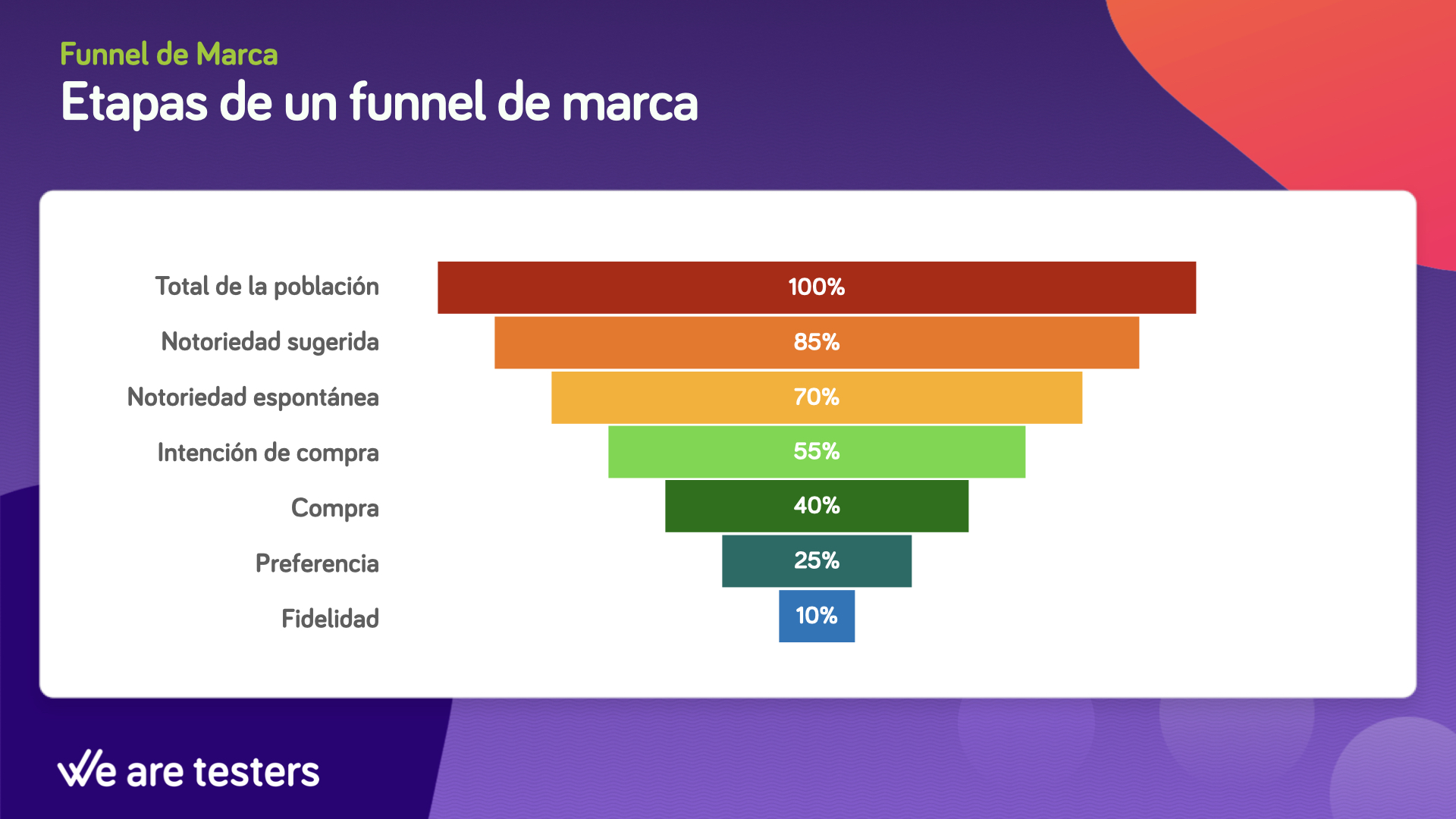
The brand funnel is a tool that helps brand managers make better decisions to grow the brand. Measuring brand metrics that make up the funnel provides a clear insight into the aspects that make the brand strong and those that still offer opportunities for growth. Today, we review all the key aspects of the brand funnel and its utility in boosting brand value and sales.
What is the brand funnel?
The brand funnel (or brand health funnel) is a model that represents the steps a consumer must go through from the moment they are unaware of a brand to becoming a loyal buyer. The number or definition of brand funnel stages may vary depending on the type of product or the researcher’s perspective, but it often includes the following:
- Total target audience: The entire set of people the product is aimed at, regardless of the brand funnel stage they are in. Expressed as a percentage, the total target audience corresponds to 100%, the total study population.
- Aided awareness: The consumer can identify the brand when mentioned or when presented with visual stimuli such as the logo, packaging, or product.
- Non-aided awareness: The consumer can recall the brand without assistance when asked about known brands within the category.
- Purchase intent (or consideration): The consumer not only knows the brand but also considers it as one of their options when going to the store, regardless of whether they have bought it or not.
- Purchase: The consumer has already bought the brand once or more.
- Preference: The consumer shows a preference for the brand and seeks it among available options when going to the store.
- Loyalty: The consumer buys this brand more frequently than alternative brands. It may not be the only one purchased, especially in high-rotation products where alternatives are commonly tried or different options are available depending on the chosen store. But it is the most frequent.
The brand funnel graphically represents how many consumers pass through each stage. Often, there is a loss of consumers between phases, such as between the percentage of consumers who are aware of the brand and those who have purchased it. Depending on where the greatest loss occurs between stages, the brand manager can prioritise and design corrective measures to increase brand health.
One of the great advantages of the brand funnel is that it can be built from a set of simple questions that can be incorporated into questionnaires of different types of market research. The brand funnel is a key component of brand research but is also frequently found in brand and advertising tracking, ad testing, and campaign effectiveness surveys. This way, the health of the brand before and after significant campaigns can be understood, and it can be calculated how advertising has helped increase brand strength.
How to use the brand funnel to improve your brand health
Depending on where the greatest contraction in the brand funnel occurs, causes can be identified, and a response can be designed:
- Low awareness: The solution is to focus on broad-reaching campaigns that make the brand and product known to large populations.
- Low purchase intent: The consumer knows the brand but is not interested in buying it. Perhaps the brand is not different enough from other options in the market, or its positioning is not relevant or credible.
- Low purchase: Consumers do not try the product. Perhaps the right level of distribution is not being achieved, it does not occupy enough space on the shelf, or its store placement makes it difficult to find. Or maybe the price is too high.
- Low preference: The product is tried but does not outperform alternatives in the market. In this case, the consumer ends up choosing other options after the first purchase.
- Low loyalty: The consumer prefers it but buys other options more frequently. Perhaps it is not available in the stores where they buy, or the consumer ends up buying other products because they are on sale or better positioned.
Regardless of the cause, brand funnel indicators will allow the marketing team to identify hypotheses, confirm them, and choose the best set of actions to increase brand health.
When to conduct a brand health funnel survey?
Conducting a brand funnel study is valuable for brand managers at any point in the life cycle of a brand:
- Launching a new brand: Measuring the brand funnel during its launch allows understanding how adoption evolves among consumers. Thus, in unexpected situations, the brand manager can make modifications to the plan to optimize their investment and achieve maximum impact.
- Periodic assessment of brand health: Measuring the funnel regularly allows evaluating the performance of marketing activities before planning the next iteration of the marketing plan.
- New campaigns and marketing actions: The brand funnel is very useful when significant changes are implemented in marketing strategies, such as a new advertising campaign, the introduction of new sales or communication channels, or the introduction of innovations.
- Launching in new markets: A brand funnel study provides valuable information on how to adapt marketing strategies to effectively reach the target audience in markets where the brand is expanding.
- Sales decline or difficulties in achieving goals: If sales goals are not being met, a brand funnel study will help understand where consumers are getting stuck on their path to loyalty.
- Sudden market changes: When a new competitor appears or if any of the brands has ceased activity, consumer preferences may adapt, modifying funnel data.
The versatility of brand funnel studies makes them a tool that can be used continuously in defining strategy and tactical marketing actions over time. Using it regularly will help understand the impact of action sets performed between two measurements. Additionally, the brand funnel is essential when making significant strategy changes or when seeking to improve the performance and effectiveness of marketing activities.
The brand funnel in the daily life of the marketing team
The brand funnel provides a set of brand health indicators that guide marketing teams in decision-making at many important moments:
- Brand strategy creation: When the brand is new or if a brand funnel study has never been done before, it helps understand where strategic priorities lie.
- Marketing plan: With a brand funnel, the marketing team can design an annual plan that includes all the learnings about what has helped move the brand health needle in the previous 12 months.
- Action evaluation: The brand funnel is particularly interesting for evaluating the impact of advertising campaigns. By measuring the funnel before and after the campaign, you can see how awareness, purchase intent, preference, and other relevant brand metrics have increased. This will provide an objective assessment of the campaign’s results and allow for identifying insights for future occasions.
It is important to note that brand funnel studies collect information about the brand itself and about other relevant brands in the category. This way, it can be seen how the brand being managed compares with the competition and understand where others have their strengths and weaknesses.
How to conduct a brand health funnel survey?
Conducting a brand health survey is easy. To do so, a representative sample of the target audience must be interviewed. The questionnaire is usually quite standard, including questions about brand awareness, consideration, purchase, preference, and loyalty. The analysis is very intuitive and is reflected in a well-known and easy-to-interpret funnel chart.
A brand funnel study can be conducted quickly and efficiently through online market research on an insights platform like We are testers. Creating the questionnaire is straightforward, and our team of research experts will help design the questions based on your category and objectives. Contact us for all the details on how to organise your brand funnel survey today.
Update date 27 December, 2023



